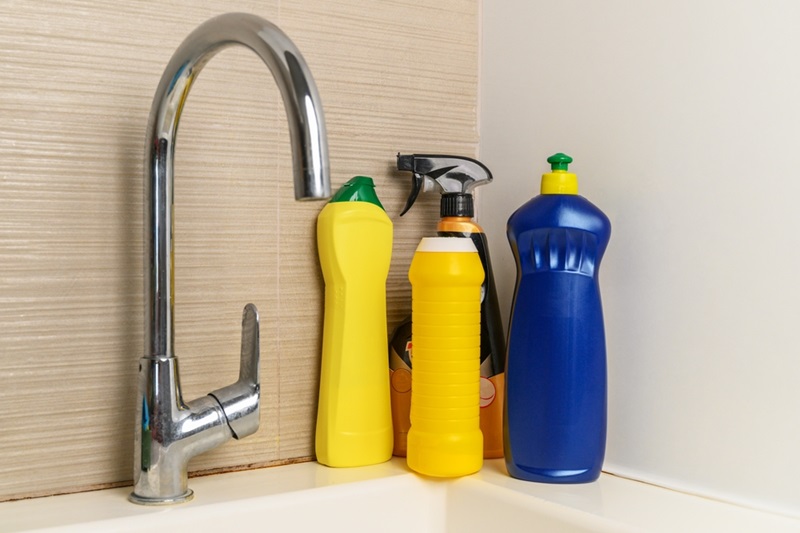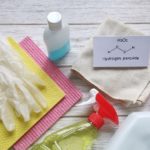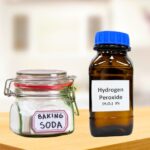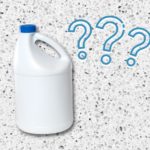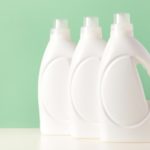It may seem like a grand plan to mix two strong cleaning solutions: hydrogen peroxide and bleach. You think you’ll get double the cleaning power, your laundry will look even better, and you can spruce up your outfits in half the time.
Unfortunately, this isn’t the case. What you’ll actually end up with is a chemical reaction that’ll be bad for you as well as your laundry!
Let’s break this down a little.
Is It Safe to Mix Bleach and Hydrogen Peroxide?
No, it’s not safe to mix bleach and hydrogen peroxide.
Chlorine bleach, a dilute solution of sodium hypochlorite, is widely known for its strong disinfecting and bleaching abilities. Hydrogen peroxide, on the other hand, is also considered a bleaching agent, has many uses in the cleaning world, and is an antiseptic.
If you mix the two chemicals, you’d assume that you’d get an ultra-powerful solution that could brighten laundry, disinfect garments, and take out unsightly stains. But, as mentioned earlier, this isn’t true.
A dangerous chemical reaction will be triggered if you combine bleach and hydrogen peroxide.
The end result of this chemical reaction is a high-speed release of oxygen gas.
Oxygen on its own might not be harmful, but the quick release of oxygen is. When the gas is released, it creates a lot of pressure and bubbles that can spill or burst out of a container. The effect is similar to when you open a bottle of pop that you’ve been shaking around. The fizziness just wants to erupt out of the bottle.
In addition, when you mix hydrogen peroxide and bleach, an exothermic reaction will be triggered. This means that the potion you’ve concocted will give off huge amounts of heat.
Couple the heat, gas, pressure and bubbles together, and you’ve made yourself a dangerous pot of “cleaning solution” that won’t clean your laundry – it will damage it – and make you feel poorly.
The rapid release of warm oxygen gas will likely make you suffer from some sort of respiratory issue, like coughing, a runny nose, and itchy, dry eyes. If you’ve been exposed to the hazardous gas, you will likely need to seek medical treatment.
By the end of the chemical reaction, you’ll have salty water (sodium chloride and water) in the tub and some oxygen gas bubbles. This liquid is highly corrosive and will damage a surface that it comes into contact with. It’s not really the environment you want to clean your clothes in.
Further to the above, how much of the solutions you use will directly impact the size of the chemical reaction. If you use a small amount of both products (hydrogen peroxide and bleach), you will see a smaller scale of the reaction mentioned above. Nonetheless, it will still be present and dangerous.
In contrast, if you increase the amount of solution you use, you will see a larger and uncontrollable response, which will be lethal.
Unless you’re a chemist and have experience dealing with these two chemicals, you’re not likely to know how much solution to use at once to limit the dangerous reaction.
This is another reason why you should steer clear of combining hydrogen peroxide and bleach. You’re likely to use the wrong “doses”, and this could prove fatal.
The Take-Home Message
Don’t mix bleach and hydrogen peroxide to create a super-cleaner! The risks of combining these two chemicals are too big to take.
Plus, your laundry won’t come out of the wash better; it will likely end up worse off and perhaps permanently damaged! Leave the act of mixing chemicals to the scientists!
In addition, when it comes to cleaning, you tend to use hydrogen peroxide or bleach. Because of its bleaching abilities, hydrogen peroxide acts as a substitute for bleach in most cases. So, there’s no real need to mix hydrogen peroxide and bleach anyway.
If you want to use these chemicals to treat your laundry/surface, consider the following:
Use one product at a time
If using both products to treat a stained garment, say a white t-shirt, treat the t-shirt with one product (hydrogen peroxide, for example), then rinse the item clean and assess the damage.
If further treatment is required, use the second product (bleach). You must make sure that you rinse the first product off the t-shirt before you use the second; otherwise, you’ll trigger a chemical reaction.
Combine a product with a safe boosting ingredient
To give your laundry an extra boost, use one of the products listed (hydrogen peroxide or bleach) alongside a safe mixing ingredient, like bicarbonate of soda.
You can use a bicarbonate of soda and bleach paste to treat mould on walls or as a soaking treatment for white laundry, for example.
Just mix the products with water
If you’re not sure what to mix hydrogen peroxide or bleach with, read the instructions on the packaging and follow the advice. If you’re still concerned, just combine your chemicals with water.
Use a stronger form of bleach
If you’re not seeing the results you want. Don’t mix hydrogen peroxide and bleach. Just use a stronger type of bleach on its own (or with water) to clean the surface.
As long as the materials/surfaces permit, switch from using oxygen bleach – a safer and gentler form – to a tougher kind, chlorine bleach.
Pair bleach with laundry detergent to tackle stains on clothes
Some dirt is tough to remove. If you’re struggling, pair oxygen bleach with a laundry detergent. The chemicals will break through the grime, de-stain, disinfect, and brighten your washing.
What to Do If You Accidentally Mix Hydrogen Peroxide and Bleach
If you’ve mixed hydrogen peroxide with a bleach-filled product, don’t panic. Follow the steps below to manage the issue:
- Open the windows to ensure airflow in the room.
- Vacate the room, and don’t let anyone in until you’ve dealt with the accidental mishap.
- Don’t rush. Deal with the situation in a calm and controlled way. The more hyped up you are, the more chance there is of you making a mess/aggravating the problem.
- When you re-enter the room, ensure you’re wearing protective gear so you don’t fall ill when you reach the fumes.
- Make sure you don’t touch the mixture. Your protective gloves should protect your hands from potential harm. If you get the mixture on your skin, it could burn or irritate it.
- Mop up any spillages with absorbent cloths. Then, dispose of them properly.
- For minor issues, dilute the bleach-come-hydrogen peroxide solution with water.
- For large-scale or delicate issues, call a professional out to help you deal with the aftermath.
- Don’t mix your hydrogen peroxide and bleach mixture with any other cleaning solutions. Adding another cleaning fluid to the mix will only aggravate and worsen the situation.
- If you or someone else feels unwell, seek medical attention immediately.
Working With Chemicals
Safety is paramount when handling chemicals. So, do the following:
- Wear protective gear – eyewear, apron and gloves.
- Don’t handle the solution near kids and pets.
- Ensure there’s sufficient ventilation in the workspace.
- Stick to the dose stipulated on the packaging.
- Use the product responsibly.
- Do a spot test with your chosen cleaner to make sure the solution doesn’t damage your item.
- Learn about what chemicals should not be mixed before you start cleaning. Hydrogen peroxide and bleach are just two solutions that should not be combined. But there are many others, including bleach and ammonia (makes chloramine gas), bleach and vinegar (makes chlorine gas), as well as hydrogen peroxide and vinegar (makes peracetic acid).

Bethan has a passion for exploring, reading, cooking and gardening! When she’s not creating culinary delights for her family, she’s concocting potions to keep her house clean!
